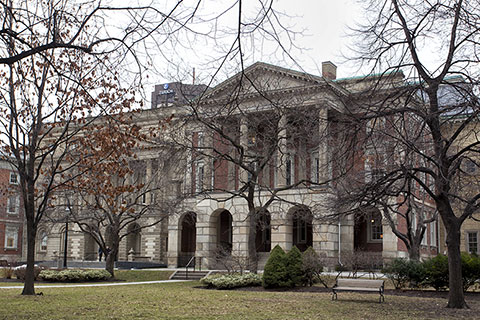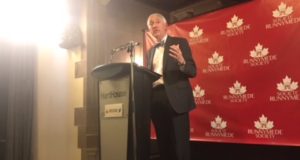Is it “antithetical” to the “Charter value” of “inclusivity” to allow a child to be excused from a public school classroom while sexual orientation or gender is being discussed? In this article I review a case that raises this very question.
Many lawyers today are concerned that “Charter values” are being used as a sword for state-enforced moral conformity, when Charter rights and freedoms are meant to be a shield to protect individuals and private institutions from government overreach.
In an earlier article on Gehl v Canada (AG), I noted that Ontario Court of Appeal Justices Lauwers and Miller raised some important questions about Charter values and cautioned against invoking them unnecessarily. Gehl was released in April. Just last week, the same two Justices raised further questions about Charter values and the Doré-Loyola framework for Charter review.
“[T]here is no need to determine that ‘inclusion’ is a Charter value, and the application judge erred in doing so,” Justice Lauwers writes in E.T. v Hamilton-Wentworth District School Board.
Christian father challenges public school’s refusal to accommodate his children
E.T, the appellant in this case, is father of two children who attended public elementary school when his dispute with the Board began. In 2010, E.T. requested that school staff notify him whenever “moral relativism”, “environmental worship”, “occultic principles”, “sex education”, or “portrayals of homosexual/bisexual conduct and relationships and/or transgenderism as natural, healthy or acceptable” came up in his children’s classes, so he could decide whether to withdraw his children from those classes.
The principal offered to excuse E.T.’s children from parts of the elementary school curriculum that dealt discretely with “sexual health and development”, but refused his request to be given notice whenever one of the items on his list might arise in the classroom.
E.T. then applied to court for “an order that the Board provide him with information, in advance, as to specific curriculum areas being taught to his children, and an order that he be permitted to withdraw the children from certain classes, lessons or activities that conflict with his religious beliefs.” He relied on both freedom of religion under s. 2(a) of the Charter and the equality protections of Ontario’s Human Rights Code.
Superior Court applies Doré/Loyola to uphold the Board’s decision
At the Superior Court, Justice Reid started his analysis with a brief recap of the two frameworks for applying section 1 of the Charter, namely Oakes and Doré/Loyola. And of course, he found that the latter applied:
[34] In this case, there is no challenge to any specific legislation, nor is there a request for judicial review. The requested relief is […] a declaration. The applicant challenges the decision of his children’s school principal, and through her, the Board. [38] […] I accept that the basic principle against which the Board’s actions must be measured is as identified by Justice Abella in Loyola: ‘[T]he discretionary decision-maker is required to proportionately balance the Charter protections to ensure that they are limited no more than is necessary given the applicable statutory objectives that he or she is obliged to pursue.’
The respondent Board’s Equity Policy committed it to ensuring that classroom practices are “anti-homophobic” and “anti-heterosexist”, and that class materials reflect a diversity of sexual orientations. E.T., however, in Justice Reid’s words, “believes that same-sex sexual relations are not God’s intention and that there are only two genders, namely male and female.”
Justice Reid accepted that E.T. had a sincere religious belief that he is obligated to protect his children from what he considers false teaching about gender, sexuality, and sexual ethics. While the respondents argued that E.T. must demonstrate that the school interfered with his ability to pass on his beliefs to his children, Justice Reid said that “it is not the role of the court to go behind his assertion that it is sinful for him to allow his children to be exposed to “false teachings”. So an infringement of religious freedom was established, and it was on to the Doré analysis.
Justice Reid noted that “the Board’s Equity Policy [is] designed to raise awareness about issues related to sexual orientation and equity with a view to eliminating stereotyping, prejudice, discrimination, homophobia and violence” and that these objectives are supported by the “Charter values” of “equality and multiculturalism”. The Equity Policy also had a “religious accommodation guideline”, which Justice Reid said was also supported by Charter values.
The decision to refuse E.T.’s request was reasonable, Justice Reid concluded. “The Board’s failure to provide accommodation by way of advance notice to the applicant was, in part, a practical response,” he wrote. The teachers had to teach an “integrated curriculum” with regard to “equity and inclusivity”, but E.T.’s list of objectionable subject matter was “extensive” and accommodating his request would be “extremely difficult”. So it was a practical decision. That much is obviously true. And of course a judge should account for such practical realities.
Superior Court and ONCA minority: Charter supports mandatory class participation
But then, Justice Reid said something I believe to be directly contrary to the Charter. He said that allowing E.T.’s children to leave the classroom when matters of sexuality orientation or gender are taught or discussed “is antithetical to […] Charter values favoring inclusivity, equality and multiculturalism.” He also noted that allowing E.T.’s children to leave “could create discomfort for those who remain (and possibly for those who are isolated.”
Reid J. then went on to quote passages from Supreme Court decisions that make the point that some cognitive dissonance is unavoidable in public school. But he makes this point regarding E.T.’s children – they will have to put up with dissonance between what is taught at home and at school. Yet avoiding cognitive dissonance (“discomfort”) for the rest of the class is supposedly a reason to not let E.T.’s children be excused from class. The contradiction seemed lost on Justice Reid, as it was on Justice Sharpe at the Court of Appeal.
Justice Sharpe, writing separately from Justices Lauwers and Miller in the result, declared: “Exempting some students on a regular basis from classroom discussions touching on diversity, inclusivity and acceptance, within a public school program designed to promote precisely those principles, would run a serious risk of endorsing the non-acceptance of students of other family backgrounds, sexual orientations, gender expressions and gender identities.”
This line of argument – that respecting a person’s (or institution’s) freedom means endorsing the views of that person or institution – threatens our most fundamental freedoms. If the state allows a Christian or Jewish or Muslim school to operate and grant diplomas, is it thereby endorsing their religious beliefs? Of course not. Nor is the state endorsing your beliefs if you are permitted to leave a classroom. We see the same argument in the Trinity Western University case – that accepting graduates from TWU’s law school would amount to endorsing the TWU’s beliefs regarding sexual ethics.
At the ONCA, E.T. loses for lack of evidence, but wins on the law
Thankfully, Justice Lauwers (with Justice Miller concurring), did not endorse this argument. Justices Lauwers and Miller did agree with Justice Sharpe on the outcome of the case, but for evidentiary reasons. There are two ways E.T. could have won, Justice Lauwers explained. First, he could have shown that the purpose of the school’s “inclusivity programming” was to undermine Christian beliefs. However, “The appellant has put forward no expert evidence that the [program] has such a purpose.” (I’m not sure what such evidence might have added.)
Second, E.T. could have demonstrated through evidence that the program as implemented “undermined a parent’s ability to transmit religious faith” in effect. He failed on this account as well. Though his children remained in public school for years while his dispute with the Board was ongoing, E.T. put forward “no evidence that his children have experienced negative teacher ‘value judgments’ of the sort he fears”.
Justice Lauwers called the Education Act’s mandate to promote inclusion and acceptance and the resulting educational programming “an iteration in inculcation”. Further, Justice Lauwers stated, “The prescribed methods are aimed at securing acceptance of the morality of the Ministry’s concept of inclusion” (my emphasis).
The majority reaffirmed the longstanding principle that “the right of parents to care for their children and make decisions … about education is primary, and the state’s authority is secondary to that parental right.” They note that “The mores contained in the [program] can conflict with parental religious views, particularly if it is premised on the proposition that true acceptance of another person can only be achieved by embracing all of their self-understandings.” They made it clear that E.T.’s loss did not mean that the programming had received “a clean constitutional bill of health”. Rather, “It would not be hard […] to imagine a teacher actively using both the force of personality and approved curriculum materials to undermine the faith commitments of students, which could make the provision of accommodation necessary.”
Further questions raised about Doré-Loyola framework
Justice Lauwers’ main problems with Doré-Loyola seem to be that it (1) obscures the priority Charter rights have over statutory objectives and (2) potentially reverses the burden under s. 1 of the Charter. A Charter value (like equality or inclusivity) can be attached to many if not most statutory objectives (such as promoting student well-being). So if someone like E.T. makes, say, a freedom of expression claim, can the state simply cancel out the claim by invoking a Charter value to counterbalance the Charter value the claimant relies on?
Justice Lauwers began by explaining the Oakes test: “In the context of Charter rights challenges to statutes, the test from R. v. Oakes gives prima facie priority to the Charter right claim, placing the burden on the state actor to establish, among other things, that the reasons for enacting the impugned statutory provision are sufficiently compelling to justify the limit placed on the right. Charter rights thus have a defeasible priority over statutory objectives.”
He then contrasted this with Doré-Loyola, in an important passage:
[110] The Doré/Loyola framework is intended to adapt the s. 1 justificatory methodology to the assessment of potential Charter infringement by decisions of administrative decision makers. I have concerns that this project miscarries in para. 4 of Loyola, which both the application judge and my colleague invoke. [111] Abella J. states in para. 4 of Loyola that, under Doré, “the discretionary decision-maker is required to proportionately balance the Charter protections to ensure that they are limited no more than is necessary given the applicable statutory objectives that she or he is obliged to pursue.” The language used by Abella J. seems to suggest that the statutory objectives have indefeasible priority over Charter rights, contrary to the Oakes methodology. Perhaps the logic of para. 4 is that if a statutory objective is pressing and substantial (understood in the Oakes sense), that would be sufficient to justify the limit of the Charter right, irrespective of any countervailing considerations. See Doré, para.6. I am uncertain. (emphasis added)
Justice Lauwers also questioned the application of Doré, which was an adjudicative decision, to non-adjudicative decisions and to “line officials” or “line decision makers” in particular (such as teachers), who lack Charter expertise.
Does a line official decide that the statutory objective she is relying on is pressing and substantial, and is she qualified to do so? “As I see it,” Lauwers J. explained, “applying the Doré/Loyola approach to a line decision maker effectively imports a presumption that the statutory objective on which the decision rests is always ‘pressing and substantial’. […] But a presumption would effectively reverse the s. 1 Charter onus to the rights claimant’s disadvantage.”
Justice Lauwers also discussed what sort of justification for a Charter-infringing decision is expected and whether it is really up to “creative lawyers when the decision is challenged judicially”. He then stated, “In my view, in order to justify a Charter limit, the record of evidence considered by the line decision maker should demonstrate the elements of accountability, intelligibility, adequacy and transparency courts expect from administrative tribunals.”
In TWU’s case, as in others, the justification for an impugned decision seems to change all the time. As I pointed out in another article, the law societies have at some points emphasized the traditional marriage component of TWU’s Community Covenant (discriminating between same-sex and opposite-sex married couples), but have also alleged that TWU discriminates in effect (though not unlawfully) against LGBTQ people, women, common law couples, singles, and non-Evangelicals. Are these sound legal reasons to not recognize its graduates when there is no question of their competence and professional ethics? Can TWU possibly have any idea of how much it would hypothetically have to change in order to please the law societies?
In my view, either the law’s societies’ authority to protect the “public interest” in the practice of law stops at ensuring those accepted into the profession are competent and ethical or its public interest authority is too vague to justify limiting freedom of religion or association. The law societies acted outside of their jurisdiction in basing their decision on a private university’s lawful internal policy. Such an approach would avoid the vagaries of Doré, under which the outcome of cases such as TWU’s will depend only on which “values” can be invoked and how valuable a judge thinks each happens to be.
The SCC will have a chance to revisit Doré/Loyola with TWU. Let’s hope it answers some of Justice Lauwers’ questions.
 Advocates for the Rule of Law
Advocates for the Rule of Law



